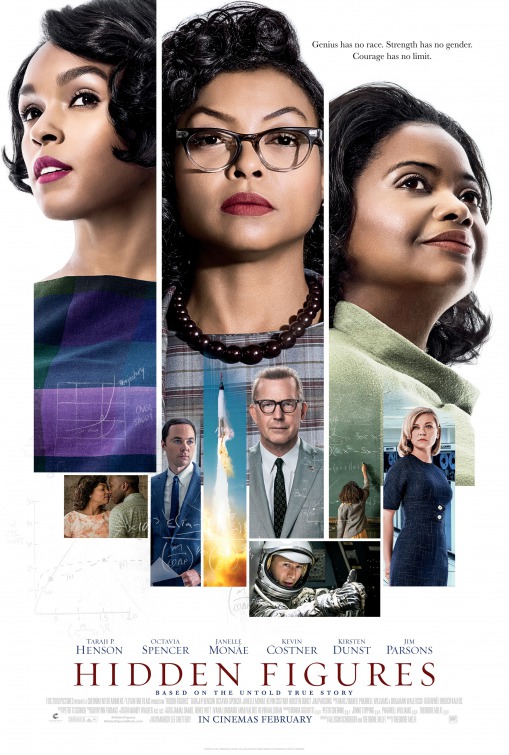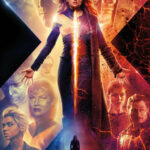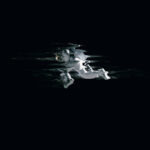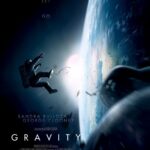Meet The Women You Don’t Know, Behind The Mission You Do
Director
Theodore Melfi
Starring
Taraji P Henson
Octavia Spencer
Janelle Monae
Kevin Costner
Jim Parsons
Kirsten Dunst
The eponymous hidden figures of this movie are three individuals working for NASA in the early 1960’s: computing supervisor Dorothy Vaughan [Spencer], engineering specialist Mary Jackson [Monae] and mathematician Katherine Goble [Henson]. Despite their exceptional talent and commitment to the space program, they are held back every step of the way by segregation, racial oppression and gender bias. With the Soviet Union making leaps and bounds in their own interstellar achievements, the American government grow increasingly frustrated with NASA’s lack of progress. In an effort to catch up, Space Task Group director Al Harrison [Costner] must push his team to crack the mathematic code and seemingly do the impossible (noting that it must be possible as the Russians have already done it). Thanks to her brilliant mind, Goble is put to work in a key position but both the colour of her skin and her gender immediately cause friction with the sitting scientists and she is met with prickly condescension and derision.
Unlike similar space race or .. race race films (take Apollo 13 or Selma), there is a deceptive air of fun running throughout which removes a great deal of the tension. This is achieved by spinning the frank and degrading horrors of segregation with subtle humour and sass. Goble’s assignment to the main facility is a wonderful promotion and fantastic opportunity but it is instantly marred when it becomes apparent that the bathrooms provided are for whites only, meaning that in order to relieve herself, Goble has to run nearly half a mile to the sister site. Again, this is a horrid fact, a hideous part of American history that can never be forgotten or overlooked but to avoid browbeating a contemporary audience (many of whom wouldn’t be old enough to have experienced such nationally endorsed division) it’s played in a light-hearted fashion with quick cuts, weather changes and an upbeat yet urgent melody. Using humour to deflect the unpleasantness of the fact works on two levels, as we get to laugh at the absurdity of the situation, thanks to our supposedly evolved hindsight and when the situation is finally brought to a confrontational head, the film takes a dramatic turn and effectively shouts, “Shame on you for laughing, this was a horrible ordeal and as much as you may think society has moved on, a great deal of it hasn’t.” But once again, that lack of browbeating shines through and a positive message is reinforced, ensuring that the only emotions one exits the cinema with will be ones of joy, hope and pride.
I’m still not entirely sure if fun is the right word to be using so I’ll use positivity instead. This positivity is well utilised but raises a few problems. The whole film is one giant message for togetherness, illustrating how much humanity is capable of if divisiveness is abandoned. Unless you’re Russian. Now, I appreciate that a line of dialogue stating anything pro-Russia would have felt anachronistic but while we’re all nodding that inclusion is better than exclusion and that our brightest and best can come from any background, we still maintain the “us and them” competitive mentality of the space race. So with a combination of a hopeful endearing story and hypocritical undertones of the bitter rivalry of two nuclear powers we end up with one of Hidden Figures’ biggest flaws: predictability. Nothing about this film is narratively challenging. Everything unfolds exactly as one would expect, robbing developments of suspense or real dramatic weight. Yet I think this might have been a somewhat intentional move. As stated earlier, a lot of attention has been paid to the script to ensure that the overriding impact of this film is one of optimism. The movie doesn’t skirt around the Civil Rights movement but it treats it with a secondary priority, as if to highlight that these women used patience and intelligence to succeed in spite of everything around them in their own way; in other words, chipping at the whitewashing of history to illustrate that a lot of people were combatting oppression in a lot of different ways, rather than just the ones shown in other movies.
For the most part, Hidden Figures is commendably shot. The production value is great, down to the costumes, hair, furniture and technology replicated on screen but either there was a problem with our print of the film or a lot of shots were wildly out of focus and hazy, which is unusual for a film with this kind of budgetary price tag. Both the editing and musical score were commendable, ensuring the pacing never dragged over the two hour runtime but neither managed to achieve anything truly gripping. Which, alongside the predictability is another fundamental drawback of this release, it rarely deviates from safe execution. From the scripted outbursts, to the elevating highs, everything is contained in an almost clinical environment which is mirrored by the film’s vanilla presentation.
The real heart and soul of this film are the fantastic central performances. Henson, Monae and Spencer are thoroughly charming and endear you to them in spectacular fashion in their introductory scene alone – but I’ll expand on that later. The supporting characters, on the other hand, are a little trickier to assess; largely for their simplistic dimensionality. On the one hand we have the leads’ respective friends and family who serve as loosely motivational points at best. Then we have all the white people. Now, I’m hardly ignorant of the past, I have no problem with depicting white people for being the shits they/we were. I also fully appreciate that any on-screen representation of any bullying or racism is watered down at best. But the film has limited time to introduce these bigoted individuals and then turn them around to the point that we can at least partly get behind them, so what we end up with are pretty bland caricatures. Costner’s hard-on-the-outside soft-on-the-inside role is acceptable but far from challenging, Kirsten Dunst plays a similar overseer who thinks and acts prejudicially but is in denial about her own intolerance and Jim Parsons plays a dick. Just.. just a two dimensionally written dick. None of them have the spite or menace to warrant the label of antagonist, they’re just examples of the day-to-day obstacles these women have had to endure since birth. But the performances aren’t good. They’re boring.
To summate, Hidden Figures is a pleasant and uplifting film which advocates learning and exceptionalism while praising unity in search of a common goal. For its minor flaws, it more than makes up for it with heart-warming developments and appealing characters.
Release Date:
17th February 2017
The Scene To Look Out For:
While the opening scene is technically a flashback, the first scene introducing us to the three leads sets the tone perfectly. Goble, Jackson and Vaughan have broken down on their way to work and the brief interactions between them highlight exactly what kind of personality and skillsets they all possess. The era and location are equally set with subtle brilliance when a police car approaches and treats the three women in distress as suspects. Only a few minutes into the film and we’ve already established pretty much everything we need to know to understand these women, their jobs and the daily plight they face in an intolerant society.
Notable Characters:
Rather than pour over the amazing lead trio, I thought I’d focus on a bit of a weird oddity. Glen Powell plays the role of astronaut John Glenn. But he is portrayed in the way a child would describe an astronaut. Glenn is this ridiculous all-American hero who’s kind, brave, charming, courageous, polite, smart and seemingly the only person who is not a racist. I mean, he’s how Superman tends to be portrayed in comics and again, adds to this impending sense of predictability. There’s no way such a man could fail to succeed. He trusts Goble and her figures, he’ll get the mission done. I have no idea why it bothered me. There’s nothing to say this wasn’t a reasonable depiction of Glenn but the cynical part of me felt like he was elevated to exceptional heights so we have an excuse to root for him, rather than having our heroines working on a rocket for a bigoted astronaut.
Highlighted Quote:
“Three negro ladies are chasing a white police car in Virginia 1961, that right there is a God ordained miracle”
In A Few Words:
“A thoroughly heart-warming and motivational release let down only by a certain lack of urgency”
Total Score: 4/5
![The Red Right Hand Movie Reviews [Matthew Stogdon]](https://reviews.theredrighthand.co.uk/wp-content/uploads/2021/12/cropped-header1.png)




